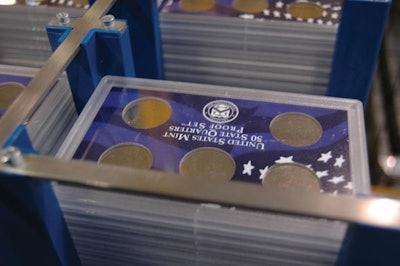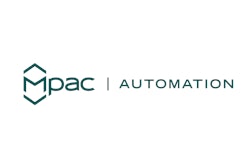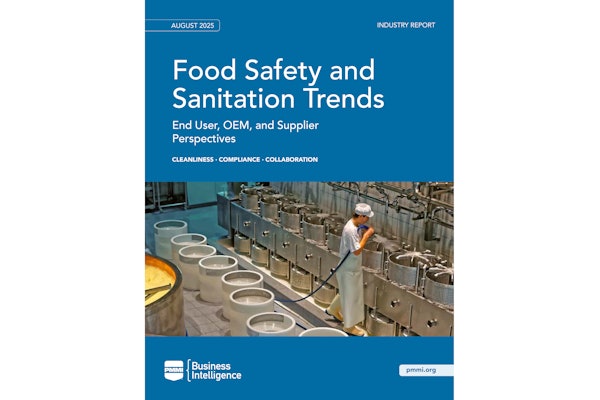The United States Mint at San Francisco has recently upgraded cartoning and casing operations for proof coins, replacing an aging packaging and product handling system with more efficient, state-of-the art equipment.
United States Mint public affairs officer Michael White explains, “Proof coins are the finest quality of coin produced by the United States Mint. Their frosted, sculpted foregrounds give them a special ‘cameo’ effect, created by the exacting proofing process. The extraordinary brilliance and sharp relief of the proof coins enable them to shimmer on the mirror-like background surfaces.
“Proof blanks are specially treated, hand-polished, and cleaned to ensure high-quality strikes. The blanks then are fed into presses fitted with specially polished dies and struck at least twice to ensure sharp, high relief.”
Intended primarily for numismatics enthusiasts and collectors, the United States Mint proof coins are placed in plastic cases called lenses, each lined with foam inserts to nest the proof coins. The lens cases, containing various coin counts, are made from crystal-grade virgin polystyrene and are supplied to the United States Mint by Rexam (www.rexam.com).
White notes, “Proof coins are sold as collectibles, and many people regard them as miniature works of art. So the packaging for these coins is selected to showcase and preserve their exceptional finish.”
Automation upgrade
The previously used cartoning system required five operators. The new, more automated cartoning line runs with two operators. “Cartoning was never our slowest packaging process,” says White. “But the new cartoning machine can achieve in three hours what our old system took eight hours to do. And the new line has significantly increased flexibility and reduced costs. The old cartoning line could only run one- and two-lens sets. The new line can carton up to eight-lens sets continuously.”
With the newly installed system, the coin-packed lenses are taken from a trolley-like magazine and loaded via two M420i robots from Fanuc (www.fanucrobotics.com) into the flights of a VENTO™ continuous-motion cartoner from Langen Packaging, Inc. (www.langeninc.com). The stainless steel-construction cartoner features hand-wheel changeover adjustment that takes about eight minutes for a trained operator. Cartoning speed is rated at 100 lenses/min.
The two robots withdraw the lenses from the four magazine trolleys. Each trolley holds one type of lens pack (single-, double-, triple-, or quadruple-coin count), and each robot has access to all four trolleys at the same time, enabling multiple lens loads. The robots load the lenses onto a bucket conveyor. This new infeed approach has greatly reduced scratching of the delicate lens faces, thus improving quality control of the packaging.
The packing configurations are verified by the robotics’ built-in machine vision system, supplied by CI Vision (www.civision.com), and rejected collations are automatically channeled to a packing reject area.
Flat, prefolded leaflets are fed from a separate magazine into two infeed buckets of the cartoner. The leaflets are deposited into the folding cartons. One end of each carton is tuck-closed, and the other end is glue-closed.
Then the cartons are discharged to the Model Axiom WACP side-load case packer supplied by Douglas Machine (www.douglas-machine.com). The case packer collates the cartons into two rows of 48 lenses, validates the product loads, and then loads them into RSC (regular slotted container) corrugated cases at a rate of one case/min. Cases are sealed with reinforced tape, and a corner bar-code label is applied and scanned for verification. An incorrect or unreadable code causes the case packer to stop and activate an audible alarm.
The finished cases are routed to the Langen palletizer, incorporating Fanuc R2000 robotics, which places the cases in the desired configuration on the desired pallet. Pallet configuration changeovers are accomplished automatically by keypad recipe selection. When the pallet is finished, the palletizer exchanges the full pallet for an empty one.
Total control
Each machine in the packaging process is controlled independently, either by a PLC or an industrial PC. The robots are controlled by the robot controller. Cartoning integration and product handling system controls were custom-engineered by Langen.
The simple-operation, easy-changeover, low-maintenance system has helped the United States Mint at San Francisco improve line efficiencies and ergonomics. The system is engineered to run 24 hr/day in three shifts, five days/week. Worker strains associated with heavy lifting, twisting, and bending to load the cartons have been reduced substantially by the robotic operation of the new line.































